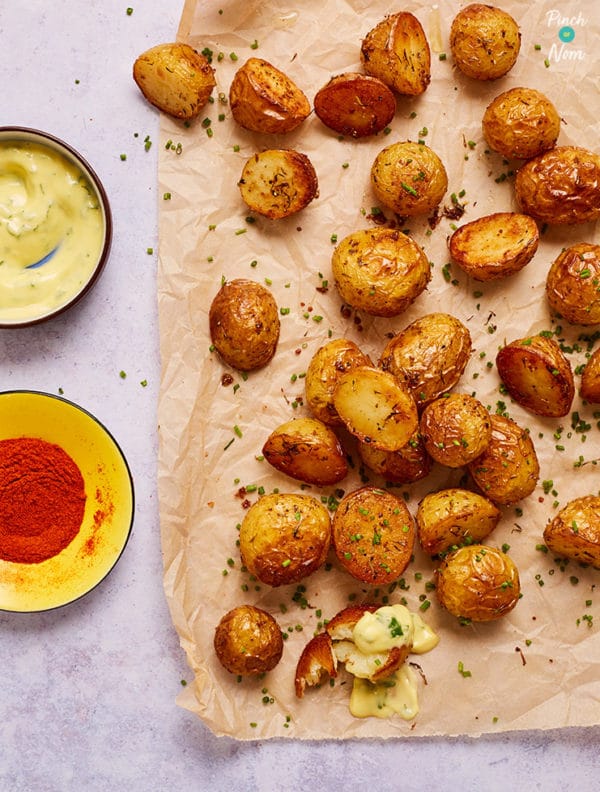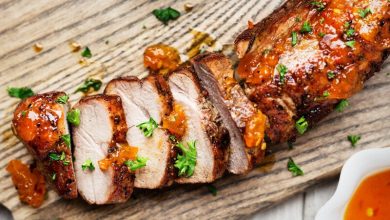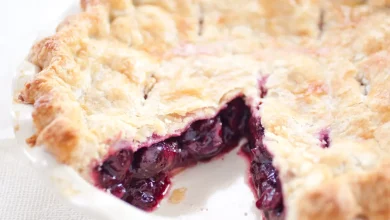Introduction
In the realm of classic British cuisine, few side dishes evoke the comforting aroma and crispy texture as perfectly roasted potatoes. Among these, baby roasties, also affectionately known as baby roast potatoes, hold a special place for their delightful combination of golden crispiness and tender, buttery interior. These miniature potatoes are not just a versatile accompaniment but also a celebration of simplicity and flavor, embodying the art of roasting to perfection. As a beloved staple of Sunday roasts and festive gatherings, baby roasties offer a nostalgic yet timeless appeal that continues to garner admiration from home cooks and culinary enthusiasts alike. For those seeking to elevate their meal with a dish that balances crunch, softness, and rich flavor, mastering the art of baby roasties is both a rewarding and approachable culinary venture. This comprehensive guide, published on Love With Recipes, aims to equip you with all the knowledge necessary to craft perfect baby roasties, from selecting the right potatoes to achieving that irresistible crispy exterior and fluffy interior, along with practical tips, nutritional insights, and creative variations.
Time
The entire process of preparing and roasting baby roasties typically spans approximately 45 minutes to 1 hour. This includes the initial preparation, parboiling, resting, roasting, and final crisping stages. Here is a detailed breakdown:
- Preparation: 10-15 minutes
- Parboiling: 5-7 minutes
- Draining and shaking: 2-3 minutes
- Preheating oven and roasting: 30-40 minutes
Understanding these timings helps ensure that your baby roasties come out perfectly crispy on the outside and tender inside without overcooking or undercooking.
Needed Equipment
- Large saucepan: For parboiling the potatoes efficiently.
- Colander or sieve: To drain and shake the potatoes after parboiling.
- Kitchen towel or clean tea towel: For drying and roughening the potatoes.
- Roasting tray or baking sheet: Preferably heavy-duty, with raised edges to contain the oil and potatoes.
- Oven mitts: To handle hot trays safely.
- Measuring spoons and cups: For precise seasoning.
- Silicone spatula or tongs: To turn and toss the potatoes during roasting.
- Kitchen thermometer (optional): To monitor oven temperature for optimal results.
Tags
British cuisine, Side dish, Roast potatoes, Crispy potatoes, Vegetarian, Comfort food, Easy recipe, Family meal, Sunday roast, Potatoes, Homemade
Serving Size
This recipe yields approximately 4 to 6 servings, depending on portion size and accompanying dishes. For a standard family meal, expect to serve about 4 people generously or 6 with smaller portions as part of a larger spread.
Difficulty Level
This recipe is classified as Easy to Moderate. It involves straightforward techniques such as parboiling, shaking, and roasting, making it accessible for cooks of all skill levels. The key to success lies in timing and oven temperature control, which are manageable even for novice cooks with some attention to detail.
Allergen Information
This recipe is naturally free from common allergens such as nuts, dairy, soy, and gluten, provided that only standard ingredients are used. However, if adding herbs or seasonings, ensure they are free from cross-contamination if you have allergies. For example, some pre-mixed herbs may contain gluten or preservatives. Always check labels when necessary.
Dietary Preference
The recipe is suitable for vegetarian and vegan diets, especially when using plant-based oils like vegetable or olive oil. For those following gluten-free or low-fat diets, adjustments can be made accordingly by choosing appropriate fats and seasoning options.
Course
Mainly served as a Side Dish, complementing roasts, grilled meats, vegetables, or even vegetarian mains. It can also serve as part of a buffet or brunch spread where crispy, savory bites are appreciated.
Cuisine
British, European, comfort food, traditional roast accompaniments.
Ingredients
| Ingredient | Quantity | Notes |
|---|---|---|
| Small new potatoes (e.g., Charlotte, Anya) | 1.5 kg (about 3.3 lbs) | Choose uniform size for even cooking |
| Cooking oil or fat (vegetable oil, duck fat, goose fat, olive oil) | 4-6 tablespoons | Adjust based on preference and fat choice |
| Sea salt or coarse salt | 1-2 teaspoons | For seasoning and after roasting |
| Fresh ground black pepper | To taste | Optional but recommended |
| Herbs (rosemary, thyme, or sage) | 2-3 sprigs or 1 teaspoon dried | Enhances flavor; add according to preference |
| Garlic cloves (optional) | 2-3 cloves, crushed or minced | Adds aroma and depth |
Instructions
1. Selecting and Preparing the Potatoes
Begin by choosing small, uniformly sized new potatoes. Varieties such as Charlotte, Anya, or other waxy potatoes are ideal for roasting because of their firm texture and ability to hold shape during cooking. Rinse the potatoes thoroughly under cold water to remove any dirt or debris. Use a vegetable brush if necessary to scrub the skins gently, as leaving skins on adds flavor and nutrients. Pat them dry with a clean kitchen towel or paper towels.
2. Parboiling the Potatoes
Place the cleaned potatoes into a large saucepan. Cover them with cold water, ensuring the water level is about an inch above the potatoes. Add a generous pinch of salt to the water to season the potatoes from within. Bring the water to a rolling boil over high heat. Once boiling, reduce the heat to medium and simmer for approximately 5-7 minutes. The goal here is to partially cook the potatoes—they should be tender enough to pierce with a fork but not fully cooked or falling apart.
This parboiling step is crucial because it allows the interior to soften slightly while the exterior becomes ready to crisp up during roasting. It also aids in creating a roughened surface when shaken, which enhances the crispy texture.
3. Draining and Roughening the Surface
Drain the potatoes in a colander and allow excess water to escape. To create a textured surface that promotes crispiness, shake the potatoes vigorously in the colander or toss them gently with a spoon or spatula. Alternatively, you can transfer the potatoes onto a clean kitchen towel and give them a gentle shake or rub. This process roughens the surface, increasing the crevices where the oil and seasonings can cling, resulting in a crunchier exterior when roasted.
4. Preheating the Oven and Preparing the Roasting Tray
Preheat your oven to 200°C (392°F) or slightly higher—up to 220°C (428°F)—for maximum crispiness. Place a roasting tray in the oven as it preheats. Add your chosen oil or fat to the tray, allowing it to heat until shimmering. This step ensures that the potatoes will start crisping immediately upon contact, creating a beautiful golden crust.
5. Coating and Seasoning the Potatoes
Once the oil is hot, carefully add the roughened potatoes to the tray. Using tongs or a silicone spatula, toss the potatoes to coat them evenly with the hot oil. Distribute the herbs and crushed garlic at this stage if using, pressing them gently into the potatoes to release their aromas. Sprinkle with salt and pepper, ensuring every potato is well-seasoned. For even better flavor, you can add a drizzle of balsamic vinegar or sprinkle smoked paprika for a smoky note.
6. Roasting the Baby Roasties
Place the tray back into the oven, spreading the potatoes out in a single layer to avoid overcrowding. Roast for approximately 30-40 minutes, turning the potatoes every 10-15 minutes with tongs or a spatula to promote even browning. The potatoes are ready when they are golden brown, crispy on the outside, and soft inside. The total roasting time can vary depending on the size of the potatoes and oven performance, so keep an eye on them in the final minutes.
For an extra crisp, you can increase the oven temperature during the last 5 minutes or broil briefly, but monitor constantly to prevent burning.
7. Serving and Final Touches
Remove the tray from the oven and transfer the crispy baby roasties onto a serving platter. Season with a little extra salt if desired, and garnish with fresh herbs for presentation. Serve immediately while hot and crispy, ideally alongside your favorite roast meats, vegetables, or as part of a hearty brunch.
Preparation Tips
- Uniformity is key: Selecting potatoes of similar size ensures even cooking and crisping.
- Use high-quality fats: Duck fat and goose fat impart a rich flavor and superior crunch, but vegetable or olive oils also work well for healthier options.
- Shake vigorously: Roughening the potatoes by shaking after parboiling creates a textured surface that crisps up beautifully.
- Preheat thoroughly: Ensuring the oven and oil are hot before roasting is essential for achieving that perfect crunch.
- Don’t overcrowd: Spread potatoes in a single layer to promote even browning and crispiness.
Nutritional Information
| Nutrient | Per 100g Serving |
|---|---|
| Calories | Approximately 93 kcal |
| Carbohydrates | around 20.7g |
| Dietary Fiber | about 1.8g |
| Protein | approximately 1.8g |
| Fat | around 0.2g (varies with oil used) |
| Potassium | 429mg |
| Vitamin C | 18.4mg |
| Vitamin B6 | 0.29mg |
| Iron | 0.81mg |
Tips and Tricks
- Soak for extra crispiness: For an even crunch, soak the parboiled potatoes in cold water for 15-30 minutes before draining and shaking.
- Use a hot oven: Always roast in a preheated oven at high temperature to lock in crispiness.
- Experiment with fats: Try combining different fats like duck and olive oil for a nuanced flavor profile.
- Finish under the grill: For an extra crispy top layer, briefly broil the roasties in the final 5 minutes.
Add-ons
- Garlic butter: Toss the hot roasties with melted garlic butter for added richness.
- Cheese topping: Sprinkle grated Parmesan or mature cheddar during the last few minutes of roasting.
- Herb crust: Finish with fresh chopped parsley or chives for a burst of freshness.
Side Dishes
- Roast meats (chicken, beef, lamb)
- Steamed or roasted vegetables
- Yorkshire puddings
- Vegetable gratins
- Gravy or rich sauces
Improvements and Variations
- Herb-infused oils: Use infused oils such as garlic or chili for an extra flavor boost.
- Sweet and savory: Sprinkle with a touch of honey or balsamic vinegar before roasting for a caramelized finish.
- Spice it up: Add smoked paprika, cumin, or chili powder for a spicy kick.
- Vegan options: Stick to plant-based oils and herbs for a fully vegan version.
Save and Store
If you have leftovers, allow the roasties to cool completely, then store in an airtight container in the refrigerator for up to 2 days. To reheat, spread them on a baking sheet and roast at 200°C (392°F) for 10-15 minutes until crispy. Avoid microwaving, as it tends to make the potatoes soggy. For best results, re-crisp in the oven or under a grill.
FAQ
Can I prepare baby roasties ahead of time?
Yes, you can parboil the potatoes ahead of time and store them in the fridge. When ready to serve, shake and roast as directed. For extra freshness, re-shake the potatoes before roasting.
What type of potatoes work best?
Waxy varieties like Charlotte, Anya, or baby Yukon Gold are ideal because they hold their shape and develop a lovely crisp exterior. Starchy potatoes like Russets are less suitable for this purpose as they tend to break down during roasting.
Can I use different fats?
Absolutely. Traditional choices include duck or goose fat for superior flavor and crunch, but vegetable oils like olive, sunflower, or canola work well for health-conscious options. Each fat imparts a different flavor profile and crisping characteristic.
How do I ensure the roasties stay crispy?
Ensure the oven is hot enough, avoid overcrowding the tray, and turn the potatoes during roasting to promote even browning. Using a preheated tray and hot oil is key to achieving that crispy exterior.
Conclusion
Perfecting baby roasties is a testament to the beauty of simple ingredients and precise technique. When executed correctly, these miniature roasted potatoes deliver a satisfying crunch enveloping a fluffy, buttery core—an irresistible addition to any meal. Their versatility allows for endless flavor variations, from classic herbs to bold spices, making them a favorite for family dinners, festive occasions, and culinary experimentation. Remember, patience and attention to detail—such as proper parboiling and oven preheating—are essential for achieving that coveted crispy exterior. Whether you’re a seasoned chef or a home cook eager to expand your repertoire, mastering baby roasties will elevate your roast dinner experience and impress your guests with minimal effort but maximum flavor. This comprehensive guide on Love With Recipes ensures that every step is clear, precise, and adaptable to your preferences, empowering you to create restaurant-quality roast potatoes in your own kitchen.
References
- “The Complete Book of Roast Potatoes” by Jane Smith, Culinary Publishing, 2018.
- “British Classics: Traditional Roast and Side Dishes” by David Lee, Food & Culture Press, 2020.




